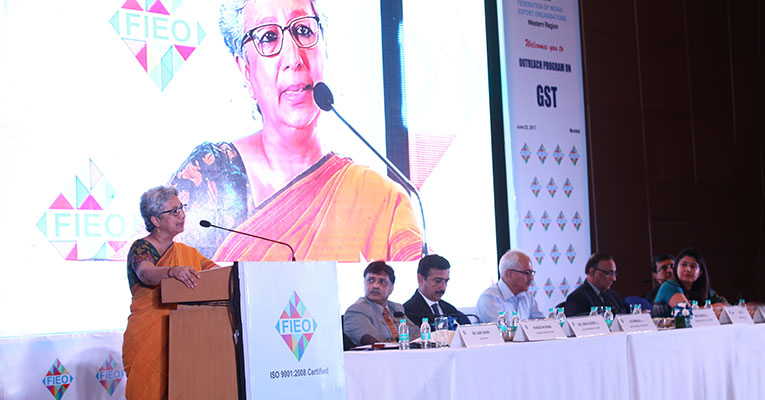All export schemes to continue in midterm review within the discipline of GST

Jun 26, 2017: While addressing the exporters during the Outreach Program on GST organised by FIEO at Mumbai Commerce Secretary Rita Teaotia said that GST has continued to evolve over the last many months in response to some of the concerns which has been flagged by the industry.
She said that the Department of Commerce (DoC) has tried to synchronise the mid-term review of the Foreign Trade Policy along with the roll out of the GST. In the normal course, the review needs to be completed by September of this year but in order to make sure there are no variance between FTP and GST. The DoC has geared up to use the introduction of GST as the main instrument to spur the growth of exports, as their will be low effect of duty on many of the items, reduction in the cascading effects of multiple taxes despite the apprehensions felt by the EXIM community ultimately resulting in lowering the cost and making our exports more competitive. She informed that the MEIS and SEIS will continue but will be aligned with GST. The DoC is reviewing the validity of the script period, the export obligation periods to make them more realistic and tied up with GSTN network so that there is a seamless process of extending benefit to the exports.
Ganesh Kumar Gupta, president, FIEO during his welcome address said that the exporting community welcomes the introduction of GST and hopes to see a soft landing during the transition period. To ensure that affects of GST gets absorbed smoothly by the EXIM community, the GST Council has taken a deep insight into various aspects of exports. However, few anomalies in the system that may become a concern for exporters are being taken up with the GST Council from time to time. Drawback rates may now only cover the basic customs duty on the inputs. He requested that the DoC may pursue with the GST Council to provide refund of CGST and SGST also through drawback so that complete tax refund both of customs duty and indirect taxes is made available at one place reducing transaction time and cost.
He cautioned that the European, Canadian, Australian and South African suppliers are enjoying exemption from GST under instrument akin to Advance Authorization. However, Indian exporter will be required to pay IGST under Advance Authorization for imports of inputs required for export production. This will affect the liquidity of exporters. Hence, GST Council may consider providing exemption from IGST under Advance Authorization to provide level playing field to Indian exporters and to help in providing competitiveness to exports.
AK Bhalla, DGFT addressing the participants said that the utilization of Duty Credit Scrips under the MEIS and SEIS Schemes will be suitably aligned with the changes in the indirect taxes under the GST regime and the validity period of the Duty Credit Scrips has been changed from 18 months to 24 months to enhance their utility and attractiveness in the GST regime. Value limit on the Free of Cost (FoC) exports for export promotion for Status Holders has been enhanced across the sectors with a special dispensation for the pharmaceutical sector. The threshold for reaching two star export house has been reduced to USD 20 Million, thereby incentivizing exporters.
The export obligation period for the EPCG scheme has been reduced to 4 years. This is a major simplification measure and will motivate exporters for early discharge of their export obligation. The concept of block-wise maintenance of exports has been discontinued. To provide relief to the exporters, applicants can now choose either the preceding three years or preceding five years for calculation of the average level of exports.
He also informed that DGFT has signed an MoU with the Goods and Services Network (GSTN) for sharing foreign exchange realisation and Import Export code data. This will strengthen processing of export transactions of taxpayers under GST, increase transparency and reduce human interface.
Khalid M Khan, Regional Chairman, FIEO (WR) initiating the program said that introduction of GST would be a very significant step in the field of indirect tax reforms in India. By combining a large number of central and state taxes into a single tax basket which will mitigate the ill effects of cascading taxes and pave the way for a common national market. Exporters will derive the benefit of GST where Export taxation under GST would be zero percent and exporters would get input credit.
Ajay Sahai, DG and CEO, FIEO made a comprehensive presentation on Exports and Imports under the new GST regime and highlighted the amendments and consequences change is procedures for exporters, EOU’s, SEZ’s, Job works, Deemed Exports etc.
The outreach program was attended by representatives of the industry, industry associations, Export Promotion Councils and other stakeholders.



